The Termosfera company, at its production facilities in Balashikha, produces an impressive range of moonshine stills, which are distinguished by their workmanship, thoughtful design and high price. In this review, we will figure out how justified the costs are when purchasing the Istochnik devices, a line for beginner distillers.
Stills
“Termosfera” has always made good cubes from honest AISI 304 with rich equipment. But the economy and the fashion for Chinese LUXSTAHL pans eventually won. In the 2018 model line, Luxstal cubes have taken a dominant position.
The main point of contention in the use of these pots in home brewing is the material from which they are made. In Russia, AISI 201 (12X15G9ND) has a sanitary and epidemiological conclusion on the possibility of using it in the food industry. In fairness, we note that Clause 5 of DIN 11850 (Materials) of the European standard indicates that only the following steels are allowed to be used in the food industry without restrictions: AISI304 (1.4301), AISI304L (1.4307), AISI 316L (1.4404).
Due to the low nickel content, AISI 201 is about 304-30% cheaper than AISI 35. Both grades are austenitic, which gives sellers reason to talk about their almost identical properties. It’s time to put an end to these speculations.
Yes, their mechanical properties, cold and hot workability, weldability, are very similar, although they have some nuances.
AISI 304 is a classic stainless steel with high corrosion resistance in aggressive environments (high humidity, precipitation, acidity) and excellent temperature properties.
AISI 201 – alloyed with chromium, manganese, nickel, nitrogen and copper. Nitrogen and manganese made it possible to reduce the amount of expensive nickel. Copper provided good ductility under deformation. But the corrosion resistance suffered. Even railings made of 201 steel will not rust only in a dry room. And on the street, in the pool, under the influence of at least rain – corrosion will declare itself quickly, and first of all in the places of welding.
Familiar to us AISI 430, from which the bottoms of pans are often made to enable their use on induction stoves, refers to corrosion-resistant steels, it does not contain nickel at all. Russian analogue – 12X17. True, normal boiler manufacturers use this brand as an insert into a three-layer “sandwich” of the bottom, so it does not have direct contact with the bulk of the cube and the atmosphere.
What to do with all this? You just need to know the weaknesses of the pans used and properly service them. First of all, wipe dry after use. Do not cover until dry.
Do not use metal “stainless” washcloths to clean surfaces – remember how often among them come across really stainless? And if you scratch the surface of the pan with an ordinary steel washcloth or brush, then small particles of iron that have eaten into the surface will be enough to start the corrosion process.
You need to be careful with detergents, especially chlorine or acid-containing ones. A widely known experiment was when a cleaning agent was mercilessly dropped onto the pans. By morning, the wetted surface of AISI 304 darkened, but the surface of AISI 201 simply corroded.
In the absence of price differences, there is no good reason to buy a cube from a problem material. In general, AISI 201 can be used for pot stills, but requires more care and maintenance.
How serious is this? The Rusich company kindly posted a photo of experimental reflux condensers after two-time use of 304 and 201 steel grades. See, decide.
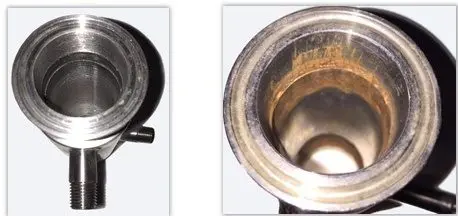
On the official website of Thermosphere, it is stated that the company produces the entire product line presented, and the cubes are made of AISI 304. In fact, this statement applies only to the cubes of the Pro series, which is clearly of its own production, they are easy to distinguish by handles and longitudinal welded seam. The rest of the cubes on the photo of the site are modestly turned upside down and the brand name is not visible.
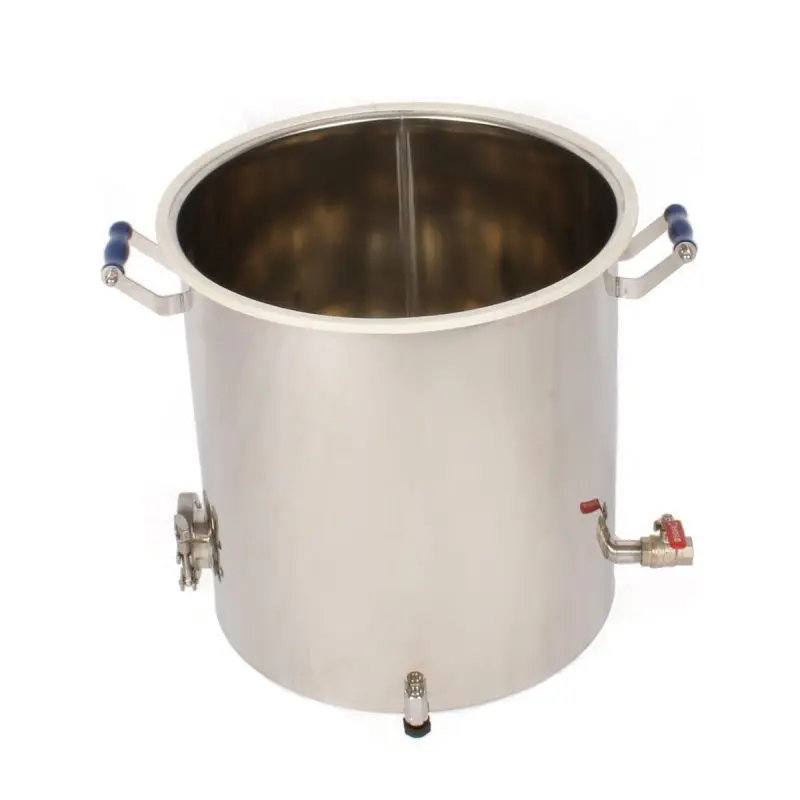
And only in individual photos and training videos does the secret become clear – we have Luxstal pans in front of us. Well, this is a very clumsy attempt to deceive the buyer.
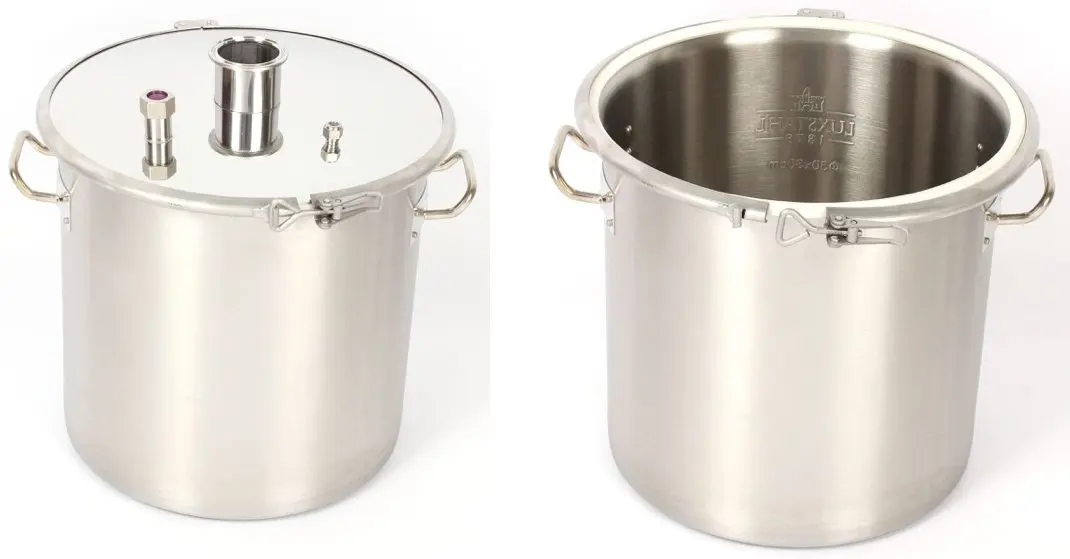
Equipment
“Thermosphere” in the 2018 model range offers cubes with volumes of 12, 20, 30 and 37 liters. By equipment, they are divided into 3 series: “Pro”, “middle” and “Light”.
All series come with caps equipped with ½” or 2” clamp connection, digital thermometer nipple and safety valve. Valve actuation threshold 0,6 atm. Not perfect, but still much closer to safety requirements than most competitors.
Cubes with a volume of 12 liters are only available in the Light series with a 1 mm thick lid.
The “middle” series is available for cubes of 20 liters and above. It is distinguished by a thicker cover – 2 or 3 mm and an adjustable clamp.
The Pro series is the most expensive in the line, it is also available starting from 20-liter cubes. “Pro” has the most complete set: a ¾” drain cock, a nipple for an electronic thermometer in the steam zone, a clamp connector for a heating element, a liquid level indicator in a cube, adjustable supports. On request, it can be additionally equipped with a heater.
The largest, 37-liter cube can be equipped with a lid with a connector for a steam supply unit. However, in the additional configuration there are also units for supplying steam, installed instead of the heating element.
For lovers of grain mash, it is possible to purchase a false bottom for a fee. True, its price is much higher than that of competitors.
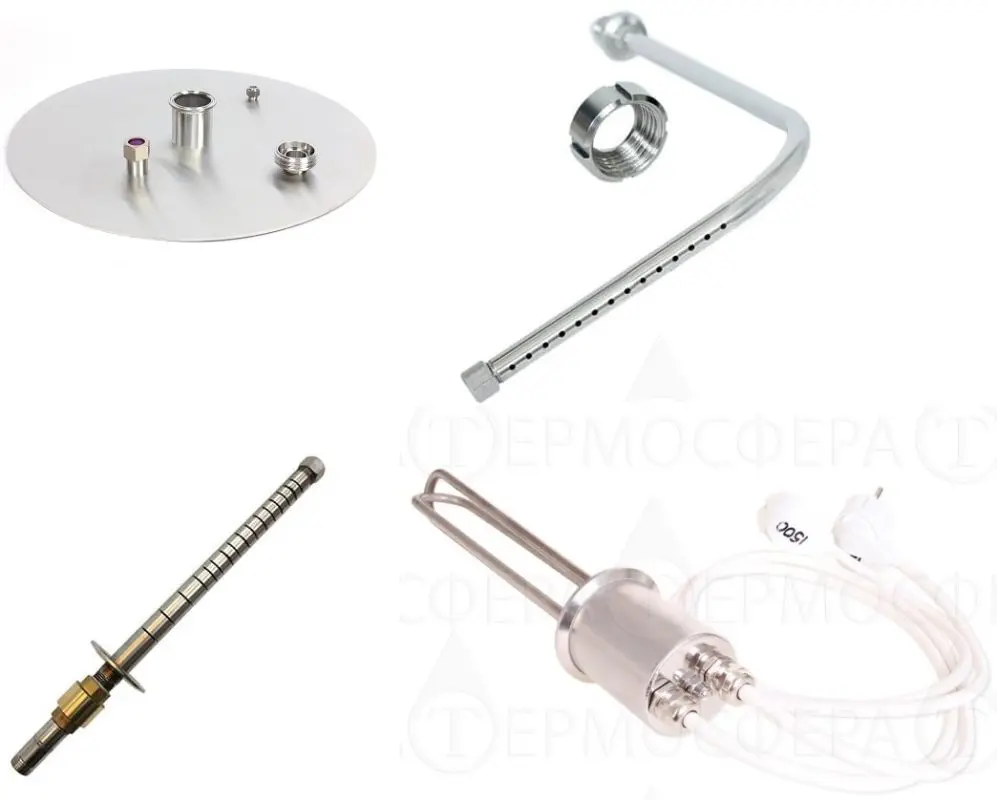
The kit also offers collapsible heating elements with the possibility of replacing heating elements. Power – for every taste. Moreover, the connection of each of the heating elements is separate, which allows you to create pairs with different power and use them separately for different stages of distillation. Heating elements are made of stainless steel AISI 304.
The quality of the welds and their processing are quite good. The complete set of cubes, both basic and additional, is beyond praise.
It is also worth noting that some of the devices, especially the entry-level ones, continue to be equipped with cubes of the 2008-2017 line. You can’t say it’s bad. On the contrary, these are cubes of Thermosfera’s own production, welded by an automatic machine with a high quality of seams guaranteed by the manufacturer. But, alas, today they are no longer such a fashionable design. Among them, the 20 liter cube deserves special attention, which, due to its size, allows most entry-level and mid-level devices to be placed under the hood in the kitchen and, in general, has a successful design. The flanges of these cubes come in three types: with a short clamp connection or diopter, and with a short side welded directly to the flange. All of them are equipped with a normal, working blast valve. It is a pity that the release of these models is coming to an end.
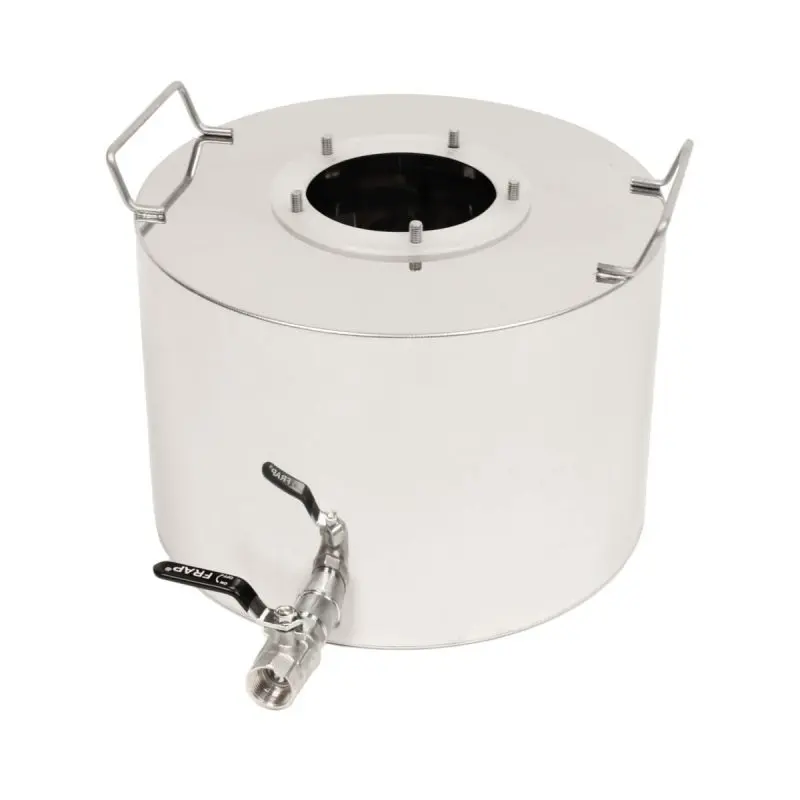
“Source Classic”
This is the most simple and low-power device. Its package includes a drawer with a diameter of 38 mm and a length of 300 mm with an on-load tap. The side can be attached to the cube through a clamp connection or simply welded to the flange.
The design is completed with a shirt reflux condenser and a once-through refrigerator. The size of the reflux condenser does not even allow one to hope for the possibility of the column operating in the self-loading mode at the rated heating power.
The refrigerator is able to condense and cool distillate to room temperature with a capacity of up to 1,5 l / h. At the limit of its capabilities and with the issuance of warm moonshine – up to 2 l / h.
A short tsarga in combination with a low-power reflux condenser copes with the spray-carrying of the mash. At the same time, the reflux condenser creates a small flow of phlegm down the walls of the tsarga towards the splashes and plays a positive role in the fight against them. Turning off the reflux condenser, due to its low power during the distillation of the mash, will not give a significant increase in productivity; in any case, the refrigerator will be the bottleneck.
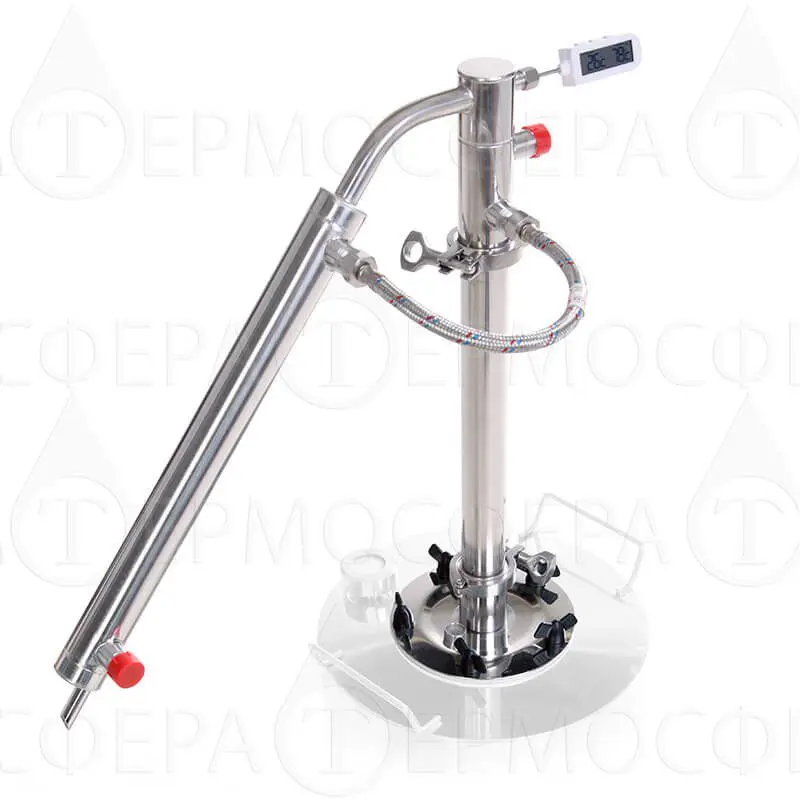
Drawer side with tap changer does not give a serious effect on cleaning moonshine. This is due to the fact that it operates in a phlegm-depleted mode. Yes, and that phlegm that enters the column simply flows down the walls, disgustingly wetting the nozzle.
According to the manufacturer, the distillate at the output has a strength of about 85%. This corresponds to about 1 step of strengthening. Adding an additional 60 cm drawer side with the same attachment increases the strength to 94%, which corresponds to about 4 steps of strengthening.
“Istochnik Classic” is an ordinary column-type moonshine with reinforcement, which can successfully take its place on a kitchen gas stove, corresponding to this type of heating in terms of its capabilities.
“Source Turbo”
“Source Turbo” is an attempt by the Thermosphere to take the apparatus to the next level. Modernization touched the reflux condenser and refrigerator. They became shell-and-tube and more powerful. Inside they have 4 tubes with a diameter of 12,5 mm.
The diameter of the drawer side has also increased to 43 mm, which, naturally, has increased the rated power compared to the 38 mm drawer side of the Istochnik Classic. This is an honest 1,5”, which is rare and deserves attention. For a BC with an SPN nozzle, this is equivalent to a 30% increase in productivity. Not bad, a very nice bonus.
The height of the drawer side in the basic configuration is 600 mm. This is enough for a 1,5” drawer side for more or less normal distillate purification. To obtain alcohol, of course, it is not enough and you need to add – at least one more tsarga. In the basic configuration, the device really became more powerful and it became possible to “lock the column” – I use the manufacturer’s terminology.
In fact, the Turbo Source consists of a powerful shell-and-tube cooler and a dephlegmator combined in one design, which each have 4 steam tubes with an inner diameter of 12,5 mm and a total length of 430 and 80 mm, respectively. When distilling mash, the refrigerator is able to utilize up to 3–3,5 kW of useful power with a capacity of up to 7 l / h. This is a good indicator. Of course, the inclined position of the refrigerator significantly reduces its cooling capacity, but the excess power for domestic purposes compensates for this.
The absence of a TCA (tube for communication with the atmosphere) in the area of uXNUMXbuXNUMXbthe refrigerator spout is a serious drawback, the consequences of which have already been mentioned more than once.
During the distillation of raw alcohol, on the recommendation of the manufacturer, the “heads” are taken at a heating power of 1 kW, and the body – 1,5 kW. Here is the time to ask a simple question: why exactly?
The answer is simple. A reflux condenser with a total length of 80 mm, and even less working one, ensures the utilization of no more than 1 kW. Therefore, having selected the “heads” in a mode far from optimal, the manufacturer advises increasing the power to 1,5 kW without touching the water supply for cooling. The extra 0,5 kW will evaporate about 2,4 l / h of distillate from the cube, which will pass through the reflux condenser and go to the selection. Naturally, on the way to the reflux condenser, this steam will take part in the processes of heat and mass transfer. The column will not choke, since its rated power is 1250 watts. This is a useful heating power, and the manufacturer says that the supplied power is 1500 W, which, taking into account the large heat losses of an uninsulated cube and column, is much less in the end.
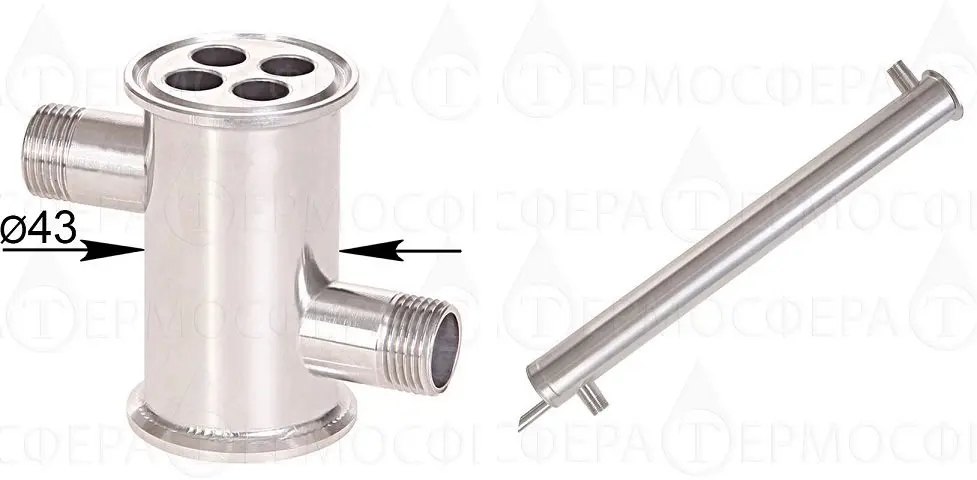
With the selection of the “body” with a supplied power of 1,5 kW and a selection rate of 2,5 l / h, we obtain a distillate with a strength of about 93%. The phlegm number in this case will be about 1,4. It is clear that there is no need to talk about a significant purification of moonshine from impurities.
However, to obtain alcohol, the manufacturer advises adding another drawer 600 mm long with SPN and reducing the speed to 1 l / h. The fortress will grow to 96%. Which gives the manufacturer a reason to talk about alcohol, because the calculated phlegm number will be approximately equal to 5.
But how to do this, because the dephlegmator worked at the limit of its capabilities already at 1 kW of supplied power? Only due to a significant increase in the supply of cooling water and the wildest supercooling of reflux. Supercooled phlegm will require from the heating column to the boiling point before it begins to participate in the processes of heat and mass transfer.
In a column 120 cm high filled with SPN, about 10-12 steps will remain in operation. The separating ability is clearly insufficient to obtain a degree of purification of the distillate that meets the requirements of alcohol GOSTs.
Strong doesn’t mean clean. For normal operation of the column in the alcohol production mode, at least 25-30 separation stages are required at the beginning of the “body” selection, and closer to the end, the reflux ratio must be increased to 7-8, thereby increasing the number of separation stages to 40-45 and limiting the amount of impurities falling into the selection to an acceptable level. But for the Turbo Source, this is already fantastic, it will no longer be possible to reduce the selection even more by increasing the water supply and increase the reflux number.
“Source Turbo” in the basic configuration remained a column-type moonshine with reinforcement, not reaching the level of BC, capable of receiving alcohol if necessary.
But “Thermosphere” offered buyers who grew out of children’s pants and realized the shortcomings of the “Turbo Source” ways to improve it. For a simple modernization of moonshine stills, the manufacturer offers to supplement them with reflux condensers from additional components 80, 150 or 200 mm long. A simple and effective move.
With the sequential installation of a dephlegmator 80 mm long in addition to the standard one, their total utilization capacity becomes more than sufficient. But the question remains: why not do this right away, not combine in one case with a good refrigerator a dephlegmator not 80, but 150 mm long? I think this question will remain unanswered.
“Source Lux”
In fact, the Istochnik Lux moonshine still is the previous Classic model with a plate-shaped cap column instead of a drawer. The device is intended for obtaining fragrant distillates from fruit and berry and grain raw materials.
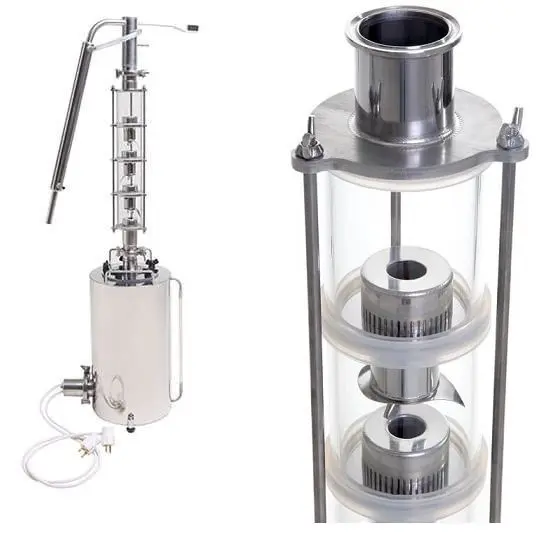
In its composition, Istochnik Lux has a 4-level tray column operating in a wide power range: from 0,6 to 3 kW. Single cap plates with central overflow. Everything is made at the modern level with impeccable quality.
It is puzzling only to complete the reflux condenser “Source”. Here, a head from the Geyser would be much more appropriate. And even better, assembled from a constructor with a reflux condenser of 200 mm with 4 tubes with an internal diameter of 16,5 mm and a powerful refrigerator for a 2” clamp.
In the same way, it looks like a bad joke. The most underpowered apparatus at the head of the most powerful column. The column will work, but not even at a quarter of its capacity. If the column did not cost three times more than the reflux condenser “Istochnik”, but on the contrary – mere pennies, then this combination could be both understood and forgiven. And so … Not even funny. Obviously, it was not technologists-distillers who worked on the configuration of this “miracle”, but brave marketers. Just some bullshit…
conclusions
- Moonshine stills “Source” from “Thermosphere” – a line for beginner distillers, which, thanks to its modular design, allows modernization and improvement as qualifications grow.
- Of the three configuration options considered, the closest in terms of its capabilities to the truth is the Turbo Source. It can be brought to mind with little cost.
- It is better to immediately assemble the device from the manufacturer’s components, and not use the models discussed above, this will avoid unnecessary costs.
Reviewed by IgorGor.









